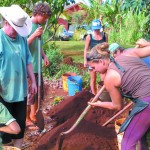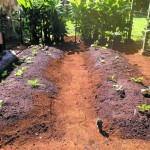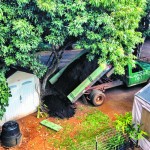Growing Your Own Healthy Food
If you read this week’s “Tastes of Kauai” column, you’ll know that my husband Dan and I are on a quest to lose weight and reclaim our health.
During the holiday season, we quit smoking, went on a juice cleanse and put in a garden. Gardening is a wonderful way to get exercise and save money while adding high-quality vegetables to our diet. While interviewing farmers for this column we have learned a lot, so I thought I’d share our process with you.
Whenever I’ve interviewed George “Sun” Hadley and Lisa Fuller of One Song Farm, they tell me it’s all about the soil. Healthy soil teems with micronutrients — microscopic bacteria that “digest” the earth, making nutrients available as food for plants.
Plants don’t need chemical pesticides or fertilizers when they’ve got great soil, so you want to enhance the soil’s biology to make it work for the plants.
Before we began, we had our soil tested. Digging no deeper than 2 inches, we scooped up about one-quarter cup of dirt from six spots in our soon-to-be garden. We stored it in a Mason jar, in the shade, until we were able to deliver it to Sun. He sent it off for testing, and then explained the results to us. The only thing our soil needed was potassium, which we could get from Happy Frog 7-4-5, available at ACE Hardware.
- Jillian Seals teaches students how to double dig | Daniel Lane photos
- After the beds are double dug, Dan Lane adds Happy Frog 7-4-5 and shapes the beds with a rake
- Double digging creates mounded beds full of air and nutrients
- Kauai Nursery & Landscaping delivers compost by the yard
- Seedlings from Heaven on Earth Starts are acclimated to Kauai
Nearly four years ago, Dan and I took a 12-week intensive organic farming course at Kauai Farm Connection, a beyond-organic farm in Kilauea led by Jillian Seals. There, among the beautiful circle beds, we learned about the importance of double digging and diversified crops.
Double digging, one of gardening’s most time-honored techniques, involves removing the top-soil the depth of a spade, setting the soil aside and then loosening the subsoil another spade’s depth. Topsoil is returned with added amendments, such as compost, feather meal or fish emulsion. This labor-intensive method aerates the soil and gives plants an excellent rooting zone.
Mono crops are fields or gardens in which a single crop, such as corn, has been planted. Diversified farming includes many types of plants, which creates a thriving ecosystem, enhancing soil quality, nitrogen fixation, pollination and pest control. Companion planting is a technique in diversified farming where plant location enhances growing. For example, cabbages thrive in the company of herbs, including dill, mint, rosemary, sage, thyme and chamomile.
One warm Saturday morning, we went to Namahana farmers market next to Kauai Mini Golf. We bought seedlings from Heaven on Earth Starts, which included rainbow chard, green cabbage, red cabbage, cheddar cauliflower, poha berry, yellow onions, leeks, bok choy, lettuces, arugula, Chinese cabbage, broccoli, kale, collards and beets.
Kauai Nursery & Landscaping delivered two yards of compost, because it is the best — and easiest — thing you can do to produce a bumper crop of vegetables. At Kauai Farm Connection, Jillian taught us to sprinkle a five-gallon bucket of compost over 50 square feet once every two weeks and after every harvest.
Growing your own food is an excellent way to stay healthy. Once a month in 2014, I will share an organic gardening technique. If you have a specific question, please email me at info@tastingkauai.com and I’ll try to answer it.
Marta Lane is a Kauai-based food writer. For more information, visit TastingKauai.com.







